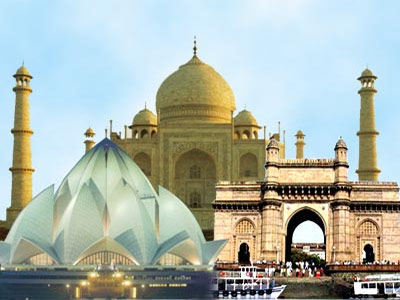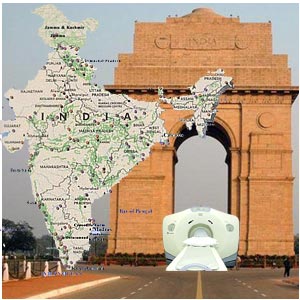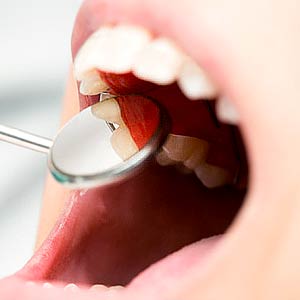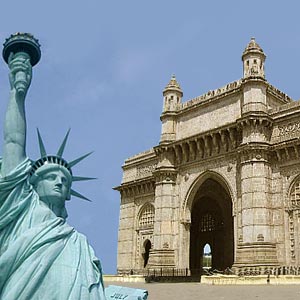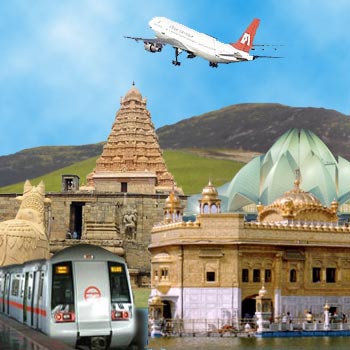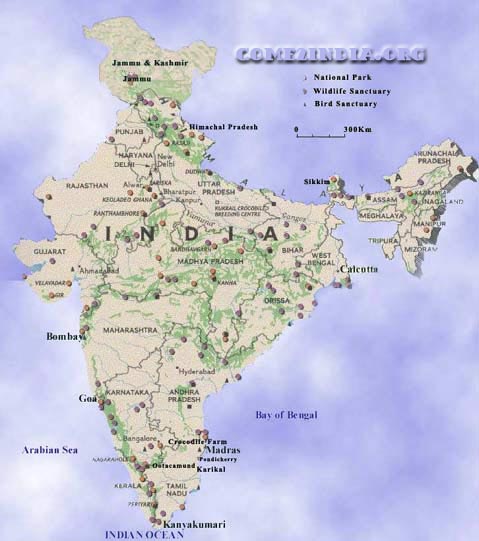Tourism in India
Tourism in India brings you face to face with startling diversity - from different terrains and languages to a wealth of regional cultures. Indian topography varies from mountains and valleys in the north to the plateau in central India to the coastal regions on the peninsular fringe. The desert of Rajasthan with its stark landscape is juxtaposed with a riot of color in the clothes and handicrafts of the region.If you are a lover of art and architecture, India offers a treat for you. The ancient monuments of Khajuraho and Hampi are but an example of the architecural splendor of this ancient civilization.
The temples of South India are not only artistically carved they are often representative of the scientific principles understood at that time. There are several monuments in Delhi and Agra that take you back to the days of the Mughal empire, rich with elaborate carvings and geometrical style.
The handicrafts of India are equally diverse and enticing. Many forms of ornamental embroidery flourish in different regions, be it chikan work and zardosi to elaborate patchwork in Orissa and mirror-work done in Kutch in Gujarat. Tribal handicrafts have their own charm.
An adventure afficiando would be enthralled by the river runnning and whitewater surfing opportunties in Northern India, close to the foothills of the Himalayas. Trekking and moutaineering opportunities are also available aplenty. You can try wind surfing and snorkeling at the many beaches.
India Tourism The rich and intoxicating history of India can be bewildering and overwhelming to a new tourist. Spiritual destinations such as Hardwar, Rishikesh, Varanasi, Tirupati, amongst many others are high on the list of pilgrim spots in India.
If you are seeking the mountains, travel to some of India's better-known hill stations. Kulu, Manali, Darjeeling, Munnar, Ooty, Kodaikanal, Dalhousie and Mussoorie are some of the popular holiday destinations.
Get set to explore India in all her different facets, from her bustling cities to the swampy mangroves of Sunderbans, from the pristine National Parks in the Himalayan foothills to the architectural glory all over. Indian cuisine is as diverse and enticing as the land. Partake of spicy curries, regional delicacies and host of aromatic spices as part of your India tour.
India - Facts and Figures
This page shows some interesting facts and figures about India. Some of the collated data might be of out of date. But the trend is evident from the facts and figures - that the population growth is galloping.
| Geography | |
| Geographic Coordinates | 20 00 N, 77 00 E |
| Area | |
| Land | 2,973,190 sq km |
| Water | 314,400 sq km |
| People | |
| Population | 1,095,351,995 (July 2006) |
| Population growth rate | 1.38% |
| Religions | Hindu 80.5%, Muslim 13.4%, Christian 2.3%, Sikh 1.9%, other 1.8%, unspecified 0.1% (2001) |
| Languages | English enjoys associate status and Hindi is the national language; there are 14 other official languages: Assamese, Bengali, Bodo, Dogri, Gujarati, Kannada, Kashmiri, Konkani, Maithili, Malayalam, Manipuri, Marathi, Nepali, Oriya, Punjabi, Sanskrit, Santhali, Sindhi, Tamil, Telugu, Urdu. |
| Literacy | 59.5% |
| Economy | |
| GDP (real growth rate) | Rs 178.636 trillion (2006) |
| GDP - Per capita (PPP) | Rs 35,183.639 billion (2006) |
| Unemployment Rate | 7.8% (2006) |
| Investment (gross fixed) | 29.2% of GDP (2006) |
| Budget | Revenues: Rs 4,834.933 billion Expenditure: Rs 6,354.954 billion |
| Industrial production growth rate | 7.5% (2006) |
| Transport | |
| Airports | 341 (2006) |
| Heliports | 28 (2006) |
| Railways | 63,230 km |
| Roadways | 3,383,344 km |
Medical tourism in India
More than 50 countries including India, Costa Rica, Cuba, Hungary, Israel, Malaysia, Singapore, Thailand and Belgium are actively promoting medical tourism. However, India stands as the preferred choice in terms of accreditations, government policies, cost, climate, culture and tourist destinations.
Like many countries, India also promotes medical tourism through government's official policy. According to the formulation drawn from the 'Policy Framework for Reforms in Health Care', drafted by the Prime Minister's advisory council on Trade and Industry, the National Health Policy 2002 of India states that the treatment of foreign patients/expatriates is legally an 'export' and the same is 'eligible for all fiscal incentives extended to export earnings.'
Medical tourism in India is a billion dollar industry. A CII (Confederation of Indian Industries) study indicates that 150,000 medical tourist visited India in 2005. According to FICCI (Federation of Indian Chambers of Commerce and Industry) the health-care market covering health insurance, is expected to expand up to $ 69 billion by 2012. The research also states that the Indian health-care industry boosted by medical tourism is growing at 30 per cent annually.
Factors promoting Medical Tourism in India
Although cost plays a major role, the reasons for medical tourism vary from patient to patient. For instance, people from US seek medical treatment that would cost one tenth of this treatment cost at home. People from other parts of the world like Canada and Great Britain are often frustrated by long waiting times at public health services.
Few like to combine their surgeries with a beautiful vacation in India that offers them scenic beaches, high mountains, religious temples, historical monuments and vast deserts. On the other hand, medical tourism in India is also a boon for poor nations like Bangladesh, where treatment options are limited.
Cost Comparisons
Cost plays a major role in promoting medical tourism in India. Using competent technologies, hospitals in India are able to perform high-end treatments like liver transplantation and heart surgery at a substantially lower rate. The following figure indicates the cost of certain treatments in US and India.
| Treatment | Procedure Cost (US$) | |
| United States | India | |
| Bone Marrow Transplant | 2,50,000 | 69,000 |
| Liver Transplant | 3,00,000 | 69,000 |
| Heart Surgery | 30,000 | 8,000 |
| Orthopedic Surgery | 20,000 | 6,000 |
| Cataract Surgery | 2,000 | 1,250 |
Accreditations/Legal Issues
Indian government has adopted an accreditation system (National Accreditation Board for Hospitals, NABH) that ensures a guarantee of service for medical tourists. The accreditation process also recommends prices for services.
In order to attain NABH's certification for medical tourism, the member hospitals must agree to dual pricing system enabling limited charges for foreigners and lower prices for domestic patients. So far, the body has approved 30 of its 120 hospital members.
International Society for Quality in Health Care (ISQUA) approves India's accreditation process. ISQUA is an international body that grants approval to accreditation bodies in the area of healthcare.
There are also international accreditations like JCI and TRENT that assure quality healthcare for medical tourists. Joint Commission International (JCI), is an US based accreditation group that evaluates hospitals outside United States since 1992. Trent International Accreditation Scheme is a trusted source for British and European medical tourists.
The India's State and National Consumer Disputes Redressal Commission generally handle any legal disputes arising from treatments for medical tourists or Indian nationals. Currently CII is making efforts to draw standards that would address any litigation arising from such treatment to be dealt within Indian Courts.
Medical Tourism Process
Contact the medical tourism provider in India if you are seeking medical treatment here. As an initial step, the medical tourism provider will ask for your medical report covering the nature of your ailment, local doctor's opinion, medical history and diagnosis. Upon receipt of your medical report, the provider helps you get in touch with a certified medical doctor or consultant in India. He/She will advise you on the treatment/surgery required.
Later you can discuss with the medical tourism provider on expenditure, choice of hospitals and tourist destinations, accommodation and duration of the stay. Ensure to sign consent bonds upon agreement. Remember to collect the recommendation letters from the consultant or medical doctors that are required for the application of medical visa.
Once you arrive as a medical tourist to India, the concerned provider will assign an executive, who takes care of your treatment and accommodation.
Medical Tourism Packages
Today, most Indian private sector hospitals are very well equipped to handle a big mass of medical tourists. Backed by the strong pharmaceutical industry these private hospitals are estimated to handle a volume of 75-80% medical tourism services year on year. India is a leading drug manufacturer that exports drugs to more than 180 countries.
There are a number of medical tourism providers that offer medical packages coupled with a vacation to experience the rich and glorious culture of India. Listed below are few medical packages offered by the medical tourism providers in India.
- Bone Marrow Transplant
- Brain Surgery
- Cancer Procedures (Oncology)
- Cardiac Care
- Cosmetic Surgery
- Dialysis and Kidney Transplant
- Drug Rehabilitation
- Gynaecology & Obstetrics
- Health Checkups
- Internal/Digestive Procedures
- Joint Replacement Surgery
- Nuclear Medicine
- Neurosurgery & Trauma Surgery
- Preventive Health Care
- Refractive Surgery
- Osteoporosis
- Spine Related
- Urology
- Vascular Surgery
- Dental Care
India has many hospitals offering excellent and effective treatments nearly in all major medical sectors like cardiology, orthopaedics, gastroenterology, ophthalmology, urology, neurology, oncology, endocrinology, paediatric surgery, nephrology, dermatology, dentistry, plastic surgery, gynaecology, pulmonology, psychiatry, general medicine & general surgery.
Dental Tourism India
Irrespective of recession and slump downs in the market, many people still travel to India for various dental treatments. Among many reasons, the major one could be the cost and dental insurance. In U.S, only 50% of the total population has dental insurance. Even those with comprehensive medical packages do not a have dental coverage.
Apart from the low dental insurance coverage, cost of the dental treatments is also extremely high in these western countries. For instance, a patient requiring root canal treatment might cost up to $600 and a tooth crowning may cost around $40000. However, same procedures cost around $35-125 in India.
Listed below is the cost comparison of dental treatment between USA and India. The figures are indicative and might vary as you approach your dental tourism provider.
| Dental procedure | Cost in USA ($) | Cost in India ($) | |
| General Dentist | Top End Dentist | Top End Dentist | |
| Smile designing | - | 8,000 | 1,000* |
| Metal Free Bridge | - | 5,500 | 500* |
| Dental Implants | - | 3,500 | 800* |
| Porcelain Metal Bridge | 1,800 | 3,000 | 300* |
| Porcelain Metal Crown | 600 | 1,000 | 80* |
| Tooth impactions | 500 | 2,000 | 100* |
| Root canal Treatment | 600 | 1,000 | 100* |
| Tooth whitening | 350 | 800 | 110* |
| Tooth colored composite fillings | 200 | 500 | 25* |
| Tooth cleaning | 100 | 300 | 75* |
Source: health-tourism-india.com
The Indian dental tourist provider offer a combination pack that enables the visiting patients to correct their teeth as well enjoy the attractions of the country, rich in culture and heritage.
Dental surgery offered in India
India is well equipped with quality hospitals and experienced dentists that assure reliable treatment. Many dental tourism providers in India offer you worthwhile dental packages. Most of them include the following dental surgery/treatment options:
- Intra mouth dental scanning
- Extraction of normal/fractured teeth under local anesthesia
- Extraction of impacted wisdom teeth
- Ceramic caps without gold under microscopic control
- Maxillary Surgery
- Dental Bridges, Porcelain/Ceramic crowns
- Bleaching
- Prosthesis on the implant/ Dental Implants
- Vertical and horizontal bone grafting
- Gum Grafting/ Gums treatment
- Palatal orthodontics
- Fluoride treatments for children
- Cosmetic dentistry
- Smile designing.
- Root Canal
- Teeth whitening
- Tooth contouring and reshaping
- Dental Fillings
India is popular for successful dental surgery treatments like dental implants and implantology. Dental implants are titanium fixtures or artificial teeth that are surgically placed in the jawbone. Over a period the titanium fixtures merges with the teeth bone through a process called osseo-integration. Once this foundation becomes strong, a crown or bridge is placed on the respective teeth.
There are different types of surgical dental implants procedure. If you are coming for dental implants to India, check with your dentist for the dental implant procedure you might require. The types of dental implant procedures include:
Root form Implant: This implant looks like the root of a tooth. If your jawbone is wide and deep enough then the implant is placed on your bone surgically with local anesthesia. However, in conditions where there is not enough width or depth in the jawbone, grafting is done to place the same. Once the implant is placed, the gums are stitched and take three to six months to heal.
Plate form Implant: If your jawbone is too narrow for bone grafting, then a plate form implant is suggested. After local anesthesia, a cosmetic dentist will place the implant on your bone and stitch the gums. While few implants are healed quickly, some might take three to six months for restoration.
Subperiosteal Implants: This is suggested in cases where the jawbone does not have enough height/width to accommodate either the root form or the plate form implant. This is a custom-made solution for your teeth and is usually placed via any of the two special methods. The first method involves making an impression of your jawbone by a cosmetic dentist. After which, he/she comes up with a custom-fit implant to suit your bone. The second methodology involves CAT scan of your jawbone. The CAT scans your jawbone and provides the dentist with a model of the same. With this model, the dental labs create an implant suitable for your jawbone.
Dental implants are usually costlier abroad. A dental implant by a senior dentist in US might cost around $3500. While dental implants in India by an experienced dentist may just cost around $800. Listed below are the indicative figures of dental implants in India
| Dental implant procedures | Cost in INR |
| Alpha Bio Dental Implant with straight abutment | 25,000 |
| Nobel Biocare-Groovy Dental Implants | 40,000 |
| Computer Guided Implant Surgery | 50,000 |
| Procelain based Metal Crown | 4, 500 |
| Procera-Crown & Veneer | 15,000 |
Cosmetic Dentistry in India
Many dental tourism providers in India also offer cosmetic dentistry package to enhance your smile and appearance. The cosmetic dentistry packages to India may include one or all of the following depending on your dental tourism provider.
Tooth whitening - If you have stained or dull teeth then this is the best option for you.
Dental Bonding - If you have a minor repair on your gaps or repair of the placed chips, then dental bonding might suit you. Dental bonding in India is relatively cheaper and solves all aesthetic problems arising from color and shape.
Dental Veneers - These custom-made moldings made of porcelain/ceramic are perfect for spaces, chips, fractures, rotated or maligned teeth, distorted, or discolored teeth.
Tooth Reshaping/Cosmetic Contouring - This is done to straighten the contour teeth.
Gum Reshaping/Gum Contouring - The procedure is done to correct excessive or uneven gums through cosmetic dental procedures/gigivoplasty that makes your smile more appealing.
Gum Depigmentation - This is done to re-color the pigments of the gum that are black or brown at times.
Inlays/Onlays - This procedure involves placing porcelain, resin, or gold filling bonds to restore a decayed or broken tooth.
Relocating to India
Many NRIs are simply opting to relocate to India with the Indian economy up by 9% growth last fiscal year thereby nurturing better career prospects for globe trotters and NRIs alike. Even with the onset of world wide recession, India seems to cope better as the Indian economy is primarily based on agriculture. With its large population and a vast number of upward mobile middle class, India is one of the few countries which still has its economy in a vibrant state. There seems to be a reverse brain-drain happening in India with the cycle having come a full circle.India has become the most favored location for outsourcing and back office operations of several MNCs across the globe. Lower wage levels and ability to speak in English are construed as core reasons for the outsourcing. With opening up of the global job market in the country and accessibility to international lifestyles, many are motivated to return and relocate in India.
But before relocating to India, there are a lot of immigration ties in the other land of opportunity that have to be severed with caution and ease. Relocation should be well-planned and though out.
Things to be done prior to relocating to India
- First and foremost one has to make up his/her mind very strongly along with the other family members before relocating to India. Only then the D-day of departure has to be finalized.
- As such, it should be well understood that India is a vast and diverse country and much depends on which part of India one wants to relocate and live in. While in some villages people survive with as low as Rs.20/- per day there are cities like Mumbai, Delhi or Bangalore with real estate as high as Rs.30, 000/- per sq.ft.
- It is necessary to thoroughly understand and appreciate the culture and tradition, religion and language, social etiquette, health care facilities, educational opportunities, Government rules and regulations, monetary system and banking options, local languages and other such intrinsic details about the country.
- It is important to take all precautions and safeguard with reference to the immigration or non-immigration status in the country before relocation. With several countries like the US changing their immigration policies quickly, it becomes imperative that the families planning to relocate do not violate the existing laws. This is especially true with 'Permanent Resident Aliens', popularly known as 'Green card holders'. These people opting to spend lengthy periods of time outside US should take abundant precautions to preserve their US permanent resident status as prolonged absences from US may present problems on their re-entry.
- Certain big decisions need to be made with respect to moveable and immovable properties before relocation.
- In case of residential house property, the options are to sell it, keep it vacant or let it for rent. In case the property has been financed, and the EMI is outstanding, then one has to find a buyer and get the loan transferred.
- In case there is emotional attachment to the household property, it could be rented out so that a steady income is found and maintenance headaches are also taken care of, provided the tenant is reliable.
- In case of cars and other vehicles, one can either sell it or take them along to the new place of relocation although it involves a lot of rigorous formalities.
- In case of living in rented premises, before departure, it is essential to terminate the existing lease with notification to the landlord, inventory check-out, disconnection of telephone and other utilities, cancellation of furniture/household appliances contracts if any, initiating refund claims for security deposits, and completing local repatriation formalities.
- Children's school or college authorities should be informed.
- Arrangements for forwarding the mails to the new address should also be made.
- Similarly information of address change should be given to banks and credit card companies.
- Money management has to be finalized and what accounts to keep and what amounts to keep have to be decided.
- All unwanted credit cards should be cancelled. However, it would be recommended to keep one credit card that is fully operational over the Internet; if necessary, a bank account accessible over the web can be opened and kept operational.
- An inventory of items that should be taken to India should be made. Items that need to be shipped and other items that can be discarded have to be listed out.
- Arrange to ship things that should be taken to India and all necessary papers including bill of lading has to be kept carefully before departing to India.
- Final shopping of things that would be taken to India has to be made.
- Air tickets for travel to India have to be booked.
- Traveler's cheques, international dollars and drafts have to be collected.
- The resignation letter to the office can be handed over after booking the air tickets.
- Pension funds and other financial accounts have to be followed and finalized.
- In case of decision to sell the car has been made, alternate transport system for use has to be arranged.
- Unwanted clothes, toys, books and other accessories can be discarded.
- Friends email addresses, mail addresses and contact numbers have to be updated.
- Magazine subscriptions should be cancelled. Alternatively inform them of change of address to India.
- All important papers, documents, manuals and receipts have to be filed and kept safe.
- The first and last utility bills and credit card statements can be filed for reference and others could be destroyed.
- Bid adieu to all relatives and friends in the foreign land.
- Finding a suitable home that meets the requirements in India should be top of the agenda on relocation. Budget and personal preferences come into play here and co-ordinated effort has to be made to search, negotiate the rent, terms and conditions, verification of lease documents and other such issues.
- The next step is to set up the infrastructural utilities including gas connections, internet and cable connections, furniture and appliances that may be necessary to set up the new home.
- School or college admissions, car rentals/purchase, recruitment of domestic help, car drivers should be the next in the order of priority.
- In case, starting a new business venture is planned on relocation, then inspection of properties for setting up the office, short listing properties based on budget specifications, liaison with real estate agencies, purchase and setting up of office equipments and recruitment of manpower for the new office should be taken up.
These days there are several good and established relocation support services ranging from city to country orientation. They aid in home search, language support, and in documentation, paperwork and other administrative formalities in the country of relocation.
Relocation consultants help both expatriate families who are unaware of the culture and etiquette and standard of living in India as well as NRIs who want to make their home in this country as cozy and luxurious as it was in the 'other' country / continent.
Indian Government and facilities for NRIs
The Indian Government is offering a number of facilities for NRIs/ PIO under RBI guidelines. They may hold, own, transfer and invest foreign currency and foreign security and immovable properties situated outside India if they hold any. They are also eligible to open, hold and maintain with an authorized dealer in India a Resident Foreign Currency account to transfer in NRE/FCNR accounts. There are also exemptions for NRIs returning to India from wealth tax for seven years after return to India.
With the Government providing conductive atmosphere and with global job opportunities abound, a wise investment in India by those wanting to relocate could earn them a handsome profit margin.
Travel Tips
Food
If you can put up with spicy food,you can try almost most of the south Indian foods.But approach with caution:some Andhra variety of mutton masala "fries" can "burn" your tongue off.For the uninitiated, it would be better to stick to Idlies,Parothas,plain rice with rasam in the case of vegetarians.
For non-vegetarians,approach only City-level hotels for Biryani.Most of the Tourist spots offer crude, ill-cooked food at unearthly prices. In some of the distant regions food usually remains a problem.Stay with bread,eggs and plantains, which will be available anywhere.For a western palate,the abovementioned suggestion would hold good too. Most cities have Chinese restaurants which offer comparatively "milder" food.
I once stayed in Periyar Sanctuary (in a nearby hotel) for about 10 days and lost about 5 kilos body weight. I had little appetite for the Kerala type coarse rice. You have regional variations in food here:Tamils and Andhra cusines depend on chillies and spices for their flavour ,whilst Karnataka and Kerala offer a "blander" food. If you have a stomach lined with steel, experiment at will.Restrict your adventure to items consisting of "land lubbers" and not sea food in particular.
You will do well to buy mineral water in 1 or 1.5 litre bottles in sufficient quantities from cities.Never consider buying water in cans,because of increased risk of contamination.
Transport
Although most of the cities are well connected by rail,road and air,I would invite you to travel by road.I have been travelling by road for the past 15 years and have covered all the southern states,I am still amazed by every different route which takes me through "unexplored territory".
Arrange for a "Tourist car" ,mostly an Ambassador car with little pretension to modern creature comfort.Hire an airconditioned car always,unless you travel in a season of deluge in a remote kerala jungle.This way you can plot your own itinerary without being a puppet for some arm-chair travel bureau executive,whose idea of "Holiday in a Tropical Paradise" might be worse than a "guided-tour" of a nuclear facility in Russia during the soviet rule.
Plan your route,using a road map (obtainable from any of the offices of the Tourist Development Corporation of the individual states) and chart your way around important towns,where you can stay.
For example, if you travel to Munnar,a hill resort in the Kerala western ghats,include Thekkady and Periyar Sanctuary (notable for its elephant herds and rare migratory birds ).Shop around in Kambam ,kumuly region for Spices.Even if you can't name them individually,the shops offer almost all the spices grown in that region in neat little packs with suitable english names.Add spice to your life.
Road Conditions
There are 3 types of Roads:Bad roads,worst roads and Indian roads.However,you have to learn to live with things you can not change.So stay mostly with National Highways and State Highways (in that order) to avoid a visit to orthopedic surgeon.
Just last January, I went on a "routine" pilgrimage to Velankanni Shrine of Our Lady of Health,12 km from Nagapattinum.On my way,from Mayilam to Pondicherry,the idyllic port town still clinging to the French way of life -I had strayed into possibly the worst "road" on earth ,where the pot holes were so deep my car's wheel "fell " into a pit and the front end hit the road,resulting in a broken Fan (?) blades which severely dented my confidence.
If you plan to foray south,use the "East coast" road which will take you up to Cuddalore.The road was recently opened to the public and well laid,barring a few "hill" sized speed breakers.If you visit India for the first time,amongst other things,one thing is sure to irritate you :The presence of speed breakers in all the roads.
Unfortunately,most of the highway engineers seem to labour under the ridiculous notion that Indian roads are "autobahns" where maniac drivers drive cars of Germanic/Prussian origin to the limits of sound travel.They fail to see the truth- that almost all the so-called roads are dirt tracks and with the prevailing traffic conditions and the roaming cattle/families on the roads,you can't even notch up 30 km per hour.
Even if you subscribe to the Gandhian philosophy of "Ahimsa" (Non-Violence),at the end of your travel ,you begin to harbour thoughts of grinding the highway people to the pulp to be spread over the dirt they have laid.
Careful planning is always essential before you turn the ignition switch.On the positive side,you can travel to any nook and corner of the subcontinent on wheels and most of the time the experience would be a pleasant one.Surprisingly, the cost of such touring can be amazingly low. Believe me !
travelling in india
Ride on the century old mountain trains meandering through valleys awash with the sound of gurgling stream or cascading falls set against the backdrop of snow-capped mountains of Himalaya. There is no dearth of travelling destinations in India.
Whether you soar high into Himalayas or peer under the ruins of the Ancient monuments dotting the landscape of Indraprastha - Delhi, you will cherish the experience of travelling in India long after your visit!
Traditional Indian Weddings
A typical traditional Indian wedding offers an insight to the region, class, caste, religion and the ethnic diversity of the predominantly Hindu India. Even Indian Christian Weddings incorporate most of the traditions of their Hindu communities.From the property brought by the bride - Streedhan, to the elaborate ritualistic wedding ceremony - Indian wedding is rich with symbolism. Dowry or the Streedhan still remains a pernicious tradition in many communities ending in untold misery to the families of the brides.
A traditional Indian wedding went into many days in the past. Recently most weddings take place in about 2 days. Each part is usually performed in the presence of a Hindu Priest who chants Sanskrit slokas. Main point of a typical Indian wedding is the tying of Mangalsutra - a small gold ornament (the design can vary based on a number of factors - caste, region, community and family tradition) tied in a yellow thread or strung in a Gold, silver or beaded chain on the neck of the Bride. She will retain this until the end of her life or her spouse's.
Every community has its own unique sangityam - or traditional ritual in wedding. A typical South Indian Brahmin has Janavasam - the bridegroom is brought in a ceremonial parade usually seated in a cabriole - open car surrounded by women carrying plates of fruits and sweets, in the previous evening. And the actual wedding ceremony takes place in the most auspicious time - Muhurtha Neram at which Kanya Dhan the bride is given in a ceremony before a Holy Fire - Vivaha Homam and the bridegroom ties the Maangalyam or Thali on to the bride.
Panigrahanam the bride's hand is held in a ceremony, Pratigna Karanam exchanging of solemn vows, Parikrama - circumambulation of the Holy Fire or Agni and Saptapadhi or visualizing Arundadi are all part of the elaborate ritualistic traditional south Indian Weddings. At the end, there is a grand lunch offered to the guests. People spend vast sums of money in marriages in an ostentatious display of their social standing in India.
We display some major sects of weddings in these pages focussing on one of the most important aspects of an Indian life - Wedding - here.

